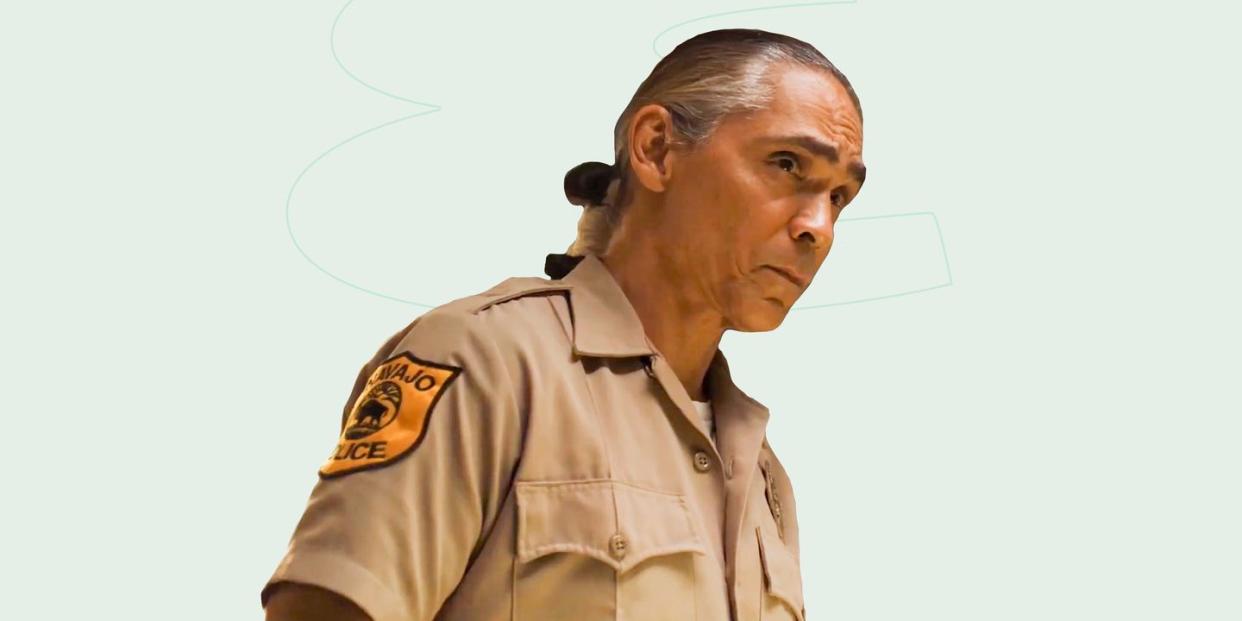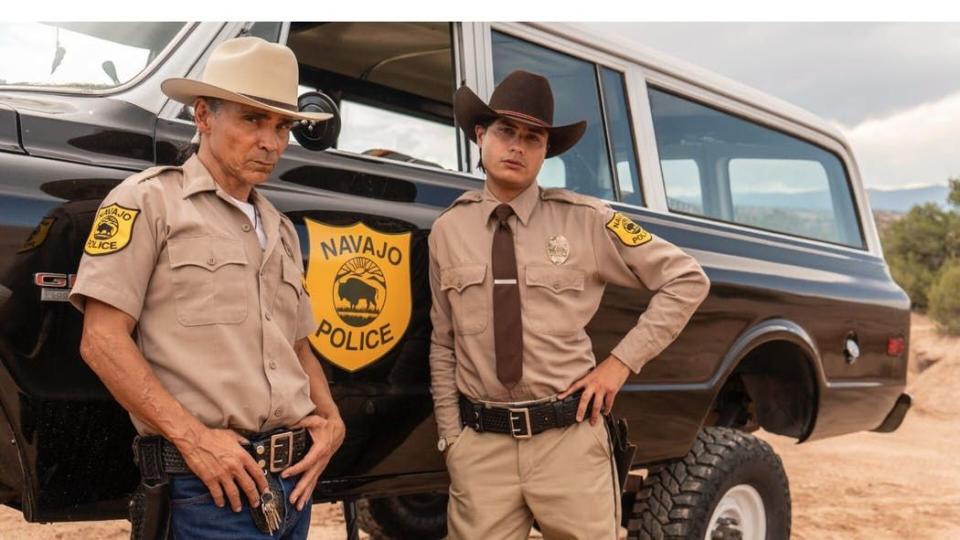'Dark Winds' Is Great Television From a Questionable Source

- Oops!Something went wrong.Please try again later.
- Oops!Something went wrong.Please try again later.
- Oops!Something went wrong.Please try again later.
- Oops!Something went wrong.Please try again later.
Like any good trilogy, the third installment in the new American wave of Indigenous television has arrived. Dark Winds lands on AMC following two previous Indigenous-led shows, Rutherford Falls and Reservation Dogs, which have blazed new comedic paths for Indigenous narratives on American TV. But Dark Winds does something different. Unlike its predecessors, Dark Winds is not a comedy—it’s a show set in a much earlier time period that delves into and incorporates witchcraft.
Dark Winds is the newest Tony Hillerman Navajo police mystery to be adapted to film and television, following The Dark Wind (1991) and the three-part PBS miniseries Skinwalkers: The Navajo Mysteries (2002). These mystery novels feature Navajo Tribal Police officers Joe Leaphorn and Jim Chee solving crimes on the Navajo reservation. Dark Winds is based on Hillerman’s 1978 novel, Listening Woman. It stars two of today’s hottest Native actors as the leads: Zahn McClarnon as Navajo tribal Police Lieutenant Joe Leaphorn and Kiowa Gordon as the younger upstart Deputy Jim Chee. If Rutherford Falls is like the classic and beloved science fiction film Star Wars, Reservation Dogs is like The Empire Strikes Back, upping the ante with more dexterity, complexity, and edginess. Likewise, Dark Winds is comparable to Return of the Jedi in that we have a mostly satisfying and polished evolution of the Indigenous narrative that doesn’t throw too many surprises at you (even though it’s a psychological thriller). Unlike its predecessors, Dark Winds runs past the half hour mark and explores the confines of the mystery genre.
Dark Winds sets up shop in the southwest on the Navajo reservation, a tribe that most Indigenous people are already familiar with and non-Indigenous people are probably most familiar with if they know anything about Indigenous culture at all. In setting up shop in Navajoland, Dark Winds showcases Navajo culture and the beautiful vast landscape in which it resides. As Leaphorn says to Chee as they patrol the rez, “On a good day, we got 50 tribal officers to patrol 27,000 square miles.” While Rutherford Falls includes the fictional Minishonka Nation in its storyline and Reservation Dogs seems to be more of an intertribal story set in the intertribal state of Oklahoma, with its characters regularly using pop culture Native slang like “skoden” and “stoodis,” Dark Winds distinguishes itself as Indigenous television that leans specifically toward Navajo content and themes.
The opening episode in the six-part series begins with a sequence seemingly influenced by The Dark Knight’s bank robbery opening. We’re thrust into a heist happening in broad daylight, right in front of a bank on Main Street in Gallup, New Mexico. Blink and you’ll miss Better Call Saul / Breaking Bad’s Jeremiah Bistui playing one of the principal criminals. Alongside McClarnon playing yet another cop, it could be argued that in this new Indigenous film and television landscape, Bitsui is now in danger of being typecast as a Navajo villain. (I’m not sure if he was actually Navajo in the Better Call Saul / Breaking Bad universe, but I’d like to think he was).
Bags of money in hand, Bitsui and crew escape in a helicopter, flying low over mountains, passing a Navajo elder tending to his sheep. Three weeks later, the elder falls ill and goes to visit a healer in a motel in Monument Valley, only to be murdered alongside a poor young Navajo girl later that night. His terrible fate: his throat slit and his eyes gouged out while the young girl curiously dies of a heart attack. Fresh from confronting and administering justice to a thief stealing precious pottery shards on the reservation, Lieutenant Leaphorn arrives onto the scene, applying traditional markings to his face to protect himself from any residual black magic before he scopes out the hotel room, discovering the dead bodies of both the elder and the young girl.
All of this happens in the first ten minutes, and it’s a lot to take in. Eventually Chee joins the fun, adorned in an over-the-top seventies style blue suit, driving a shiny El Camino and blazing by a Navajo family whose car is broken down with no help in sight. Chee has been away for a while and is disconnected from the rez and his people; now, he’s on a mission to meet Leaphorn at his new station. He’s got his reasons for coming back home and holds them close to the vest. As the Navajo healer later tells Leaphorn, amidst all of this turmoil, “There are those among us who are not what they seem.” And so, things are set in motion. Leaphorn wants to find out who killed the sick elderly man and the young Navajo girl—a girl to whom he has familial ties—and also, there’s the mystery of the robbery on Main Street. Who did that, and why did they fly off in the direction of the Navajo reservation?

Dark Winds steers the conversation away from the half hour comedy stories of Rutherford Falls and Reservation Dogs, and toward a more serious tone. That tone is decidedly darker. Lots of brown, black, blue, and gray hues—with ominous thunderstorms lurking just beyond the horizon, it’s southwest noir. Where a show like Reservation Dogs keeps things mostly lighthearted (until later in the season), Dark Winds starts off serious and continues that way. The performances by the cast hit all the marks. As Leaphorn, McClarnon is superb. So much of his acting comes from his eyes and mouth. There’s a fascinating curvature that curls from the bottom of his chin to the corners of his mouth—a slither that expresses so much about how he feels and thinks, especially when his face is lit by the golden New Mexican sun. His performance is subtle and subdued, and comes across with a special authenticity.
Meanwhile, Gordon channels a Native pretty boy returning to the reservation, subtly coupling ambition with an inherent, complicated draw to his homelands. Chee has his own goals and dreams of a life away from the Navajo reservation, but he is also of and part of the land—he can never escape that. As Leaphorn’s second in command, Jessica Matten adds a much-needed female element and energy to the Navajo Tribal Police Department. Her charismatic performance draws you in; as a tough-as-nails Navajo police officer, she keeps to herself, lives in her own trailer home, owns horses, and keeps a keen eye on anything that might disrupt her way of life, including Chee. She is very tuned into her community and the land she patrols—so much so that Leaphorn, who doesn’t trust much, tells her that he does trust her instincts.
While this foray into a longer form and a new genre of Indigenous-themed television is fascinating, I do miss the laughter that Reservation Dogs and Rutherford Falls bring to the table. I understand, of course, that they are different shows doing different things, while Dark Winds aims to explore what an Indigenous writing staff and director can do within a different genre. I get that. I welcome and applaud that.
Still, it’s hard to ignore the elephant in the room: the show is essentially based on a white man’s set of characters, with Hillerman’s Listening Woman listed as the source material. There is so much emphasis on witchcraft that there is borderline cultural fetishism; it nearly exoticizes Navajo culture to the point to where you can imagine the takeaway for a non-Indigenous viewer might be, “Oh yeah, that show. I’ve seen it. It’s about the Navajos—they do the witchcraft stuff.” I get that it’s an interesting, “exotic” subject for a non-Indigenous audience, but one wonders if, given the opportunity, would a Native showrunner and staff go this route? It’s certainly an important part of how AMC is advertising the show; Donavan’s “Season of the Witch” plays a prominent role in the trailer. For me, this emphasis runs right up to the edge of exploitation.
Of course, when it comes to the making of these types of shows, there will always have to be some compromise. It’s hard to go wrong when you have the backing of Sundance Institute founder Robert Redford and Santa Fe local George R.R. Martin as executive producers; both are proven supporters of Indigenous cinema. I suppose you can’t expect Indigenous creatives from top to bottom for every production. This is probably a good problem to have in 2022, in that the fight just to have actual Indigenous actors and creatives in these positions was a hard enough goal to achieve.
That said, it’s amazing in 2022 to see a third Indigenous series staffed with Indigenous writers and actors, and also directed by an experienced Indigenous director, Chris Eyre, who has directed these characters before in Skinwalkers: The Navajo Mysteries. Dark Winds displays yet another facet of the Indigenous narrative and checks off a new genre box in what Indigenous storytelling has to offer. Long gone are the days when Navajo actors cleverly spoke their language while they were filmed in westerns, making fun of the white directors right in front of them; now they have the power to speak their language for real within their own stories. There are many more Indigenous stories on the horizon, with more waves and more movement into new genres. Likely that will come with more opportunities for Indigenous actors to spread their wings. The concept of there being enough Indigenous work for Indigenous actors to be typecast was never even a dream of a possibility before now. And while this exciting “trilogy” of Indigenous television ends for now, it is by no means the end. There are many more stories coming to a screen near you, starting with the upcoming second seasons of Rutherford Falls and Reservation Dogs later this year.
You Might Also Like

